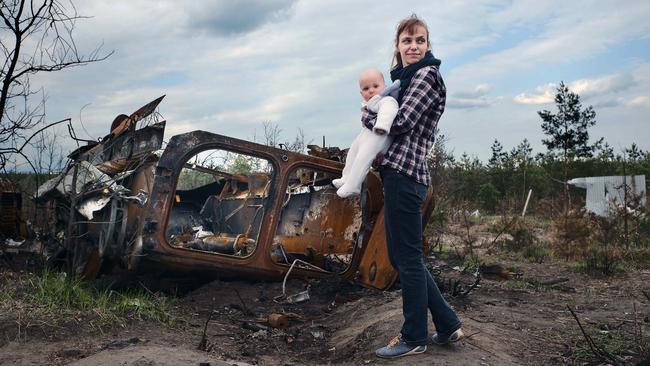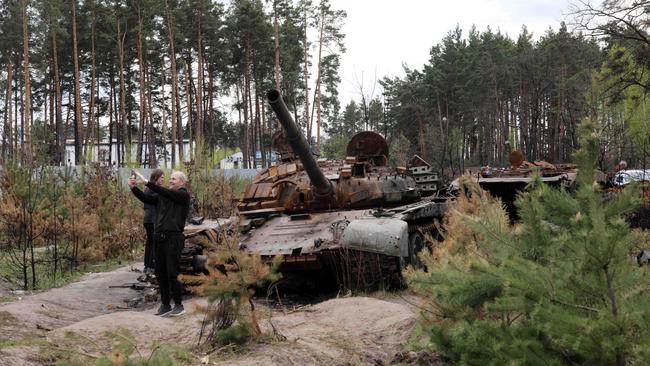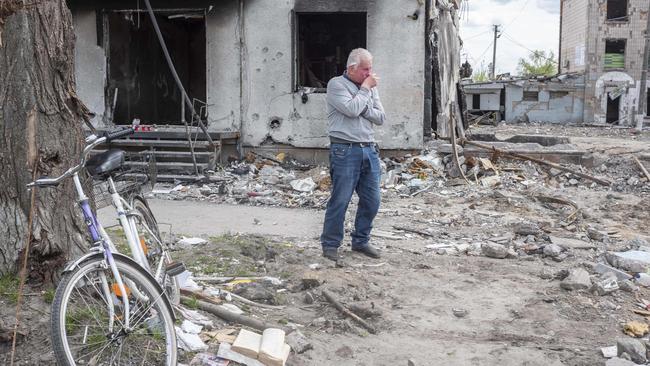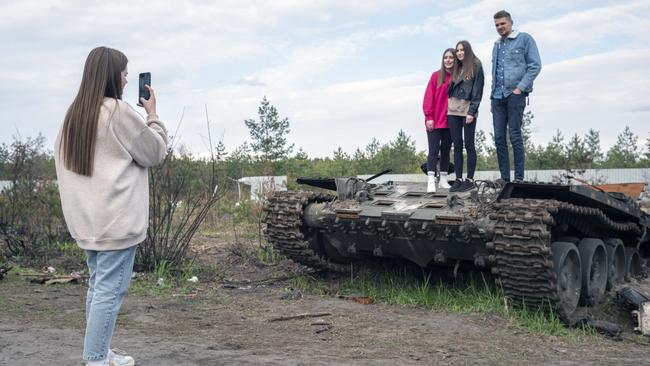Ukrainians return to the horrors of their scarred nation
Ukrainians are flooding back into their homeland and have even begun visiting the sites of some of the worst Russian atrocities.

Ukrainians are flooding back into their homeland, believing the situation in western areas of the country are safe, and have even begun visiting the sites of some of the worst Russian atrocities.
Areas such as Bucha, where scores of residents were bound, tortured and shot with their hands tied behind their backs, and Borodyanka, described by President Volodymyr Zelensky as the scene of the worst war crimes, have been visited by high-ranking politicians from around the world, but also by domestic tourists from Kyiv and Lviv and other western Ukrainian villages.
At a “tankyard” of about half a dozen destroyed Russian vehicles in a small village of Dmytrivka, 70km north of Kyiv, Ukrainian families were taking selfies as momentoes of the horror they have endured.
For Kyiv local Kseniia Bondruchuk, seeing the tanks was a day out for her and her eight-month-old baby, Anton.
The tangible evidence of damage done to Russia, instead of the devastation of Ukrainian buildings helps to buoy her spirits and provides some hope for the future. She just wants to make sense of what has been happening.

In Dmytrivka, Ukrainians brazenly not only sit on the tanks, but kick around lying munitions and venture into the nearby grass, unaware of the lurking danger of landmines.
War tourists can also see the debris of a Russian Su-25 downed near Vyshgorod which has been put on display in a Kyiv street, not far from the President’s office.
But it is also obvious Ukrainians are intensely grieving for lost ones and their destroyed communities.
In Borodyanka an elderly man rode his bike to the remains of a 10-storey high-rise. On both sides of the mangled building there were fridges and sinks hanging precariously from ripped apartments. The man gingerly placed a bouquet of flowers amid the rubble next to a giant crater. He then burst into uncontrollable tears as he prayed.

While the Russians retreated from the areas around Kyiv several weeks ago to focus on pounding eastern areas of Ukraine and a new assault on Odesa, there continues to be sporadic shelling in the nation’s capital.
In the southeastern besieged city of Mariupol where 1000 civilians and about 2000 Ukrainian fighters are sheltering in the Azovstal steel plant, more than 100 people were evacuated on Sunday and Monday, with more evacuations, co-ordinated through the UN planned in the coming days.
“I can’t believe it,” evacuee Natalia Usmanova told Reuters. “Two months of darkness. When we were on the evacuation bus I told my husband, ‘Vasya, we won’t have to go to the toilet with a flashlight’.”
More than 1.2 million Ukrainian citizens have re-entered the country since the February 24 invasion, with an obvious increase in the numbers of women and children heading back to their homes after spending several weeks with relatives in Europe, being hosted by families across the continent or spending time in refugee centres.

The daily Ukraine-bound trains leaving from Warsaw and Przemysl Glowny in Poland are now packed with families, a distinct change from the early days of the war when it was predominantly men who had been working overseas heading back to help with the war effort.
Andriy Demchenko, spokesperson for the State Border Guard Service of Ukraine, said “we have seen a certain increase in the number of Ukrainian citizens returning home.They are no longer mostly men, but also women, children and elderly.”
Officials say more than 50,000 people are entering Ukraine each day.
Mr Demchenko said the influx was from “citizens who actually escaped the war before, and now they see that the situation in the western regions is more or less calm, and they want to be at home”.
Last month regional officials urged people to stay outside the country at least until the end of May so that the areas formerly occupied by Russia just north of Kyiv could be cleared of landmines and other boobytraps.




To join the conversation, please log in. Don't have an account? Register
Join the conversation, you are commenting as Logout